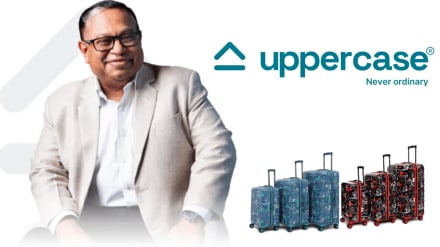When Sudeep Ghose launched Uppercase in 2022, India’s luggage market was dominated by VIP, Samsonite, and Safari, which together hold more than 85% market share. Ghose, who spent five years at Samsonite and eight-and-a-half years at VIP, saw room for a brand built around sustainability and design, rather than price or distribution.
“Uppercase was started in the midst of COVID. When the world was shutting down, we were starting a luggage company. It is something that I couldn’t believe happened. But people believed in us,” Ghose recalled in conversation with financialexpress.com. The company, incorporated in 2021 and operational from 2022, operates under Acefour Accessories.
Uppercase operates out of Mumbai with a 50-member team and a factory that handles end-to-end production. The company’s products are made entirely in India, from recycled plastics to the final assembly. “Not a single screw is imported. We believe there is value in making it here,” Ghose said.
Revenue and growth
Financial statements show that Uppercase, owned by Acefour Accessories, reported revenue of Rs 63.9 crore in FY24, up from Rs 11.1 crore in FY23, according to ROC filings accessed by Tofler. Operating revenue comes almost entirely from sales of eco-friendly trolleys, backpacks, and duffel bags. The company’s losses narrowed to Rs 17.5 crore in FY24 from Rs 21.7 crore in FY23. It projects an ARR of Rs 150–180 crore for the current year, with profitability targeted by FY26.
When compared to the competition, Mokobara’s revenue from operations more than doubled from Rs 53 crore to Rs 117 crore in December last year, while Nasher Miles clocked over Rs 165 crores in FY24. While the market leaders like Samsonite International recorded 22% growth in sales at Rs 2,298 crore, with net profit rising 24% during its financial year ended December 2023. Whereas, VIP Industries saw a 10% sales growth at Rs 2,215 crores with a profit of Rs 28 crores in FY24.
Uppercase derives roughly half its revenue from digital channels, with the remainder coming from 1,800 multi-brand stores across India. “Online is growing faster in the category, but for us, the split is roughly 50-50. We are capturing the market in both segments,” Ghose noted. The company has limited SKUs to about 500, with hard luggage accounting for 70% of sales and backpacks and office bags making up the rest.
Premium luggage brands face thin margins and a low repeat purchase cycle, typically once every three to four years. Sustainability and design can differentiate, but consumer adoption outside metro cities may be slower. As far as sustainability is concerned, Uppercase claims to manufacture its hard-backed polycarbonate luggage using a combination of virgin polycarbonate and recycled polycarbonate, as compared to other manufacturers who use 100% virgin plastic. Though not carbon-neutral, Uppercase consistently keeps virgin plastic use lower than most competitors.
Brand strategy and international plans
Uppercase has received a Red Dot design award and participated in Paris Fashion Week, according to the company. Cricket player Jasprit Bumrah has been associated with the brand since its launch and became an investor six months ago. “Jasprit’s association helps with recognition, especially for a new brand,” Ghose added.
Looking ahead, Uppercase plans to enter the Middle East this year and Europe next year. Ghose says international expansion requires a stable factory and consistent quality: “When you sell in Europe, quality has to be world class. That’s why we waited until our factory was ready.”
Domestically, the company has begun exploring tier-2 and tier-3 cities, though Ghose notes that the adoption curve differs: “Tier-1 and tier-2 cities behave similarly. Tier-3 is more conservative, cautious about investing in new brands.”
Distribution and channels
Uppercase’s sales are split roughly evenly between online and offline. “Actually, we are 50-50. Some months it’s 60-40, some months 40-60. But on average, we are 50-50,” Ghose noted.
India’s luggage market remains price sensitive, with low brand loyalty in the mass segment. Experts opine that sustaining this growth will require consumer awareness, distribution depth and the brand’s ability to maintain quality.
Uppercase’s repeat sales largely come from backpacks and business bags, which have a shorter replacement cycle than hard luggage. Ghose noted that family purchases also drive repeat sales. Its backpack, a little on the expensive side, retails for anywhere between Rs 1,000 to Rs 4,000, while its suitcases start upward of Rs 3,000. This is slightly higher than other economic options as provided by VIP and Safari.
Market context
India’s luggage market remains semi-commoditised, with low brand loyalty in the mass segment and significant imports keeping prices competitive. While premium and mid-premium segments are expanding, new entrants like Uppercase face the challenge of balancing design, sustainability, and scale.
Uppercase aims to earn Rs 500 crore over three years by opening 250 exclusive stores. Profitability is expected by FY26, with a potential IPO around FY30.
“Most startups in this category are traders; they import and sell. We are trying to make something in India, which also means giving back to society,” Ghose says. “We support close to 1,000 families through this operation. That, to me, is part of building a sustainable business.”
